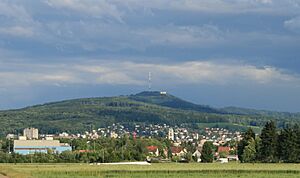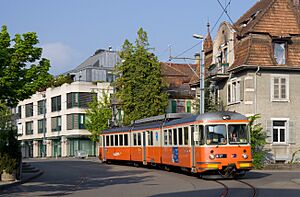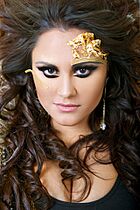Dietikon facts for kids
Quick facts for kids
Dietikon
|
||
|---|---|---|
 |
||
|
||
| Country | Switzerland | |
| Canton | Zurich | |
| District | Dietikon | |
| Area | ||
| • Total | 9.34 km2 (3.61 sq mi) | |
| Elevation | 388 m (1,273 ft) | |
| Population
(Dec 2020 )
|
||
| • Total | 28,057 | |
| • Density | 3,004.0/km2 (7,780/sq mi) | |
| Postal code |
8953
|
|
| Surrounded by | Bergdietikon (AG), Geroldswil, Oetwil an der Limmat, Schlieren, Spreitenbach (AG), Unterengstringen, Urdorf, Weiningen | |
| Twin towns | Kolín (Czech Republic), Braggio (Switzerland), Renens (Switzerland) | |
Dietikon is the fifth biggest city of the canton of Zürich in Switzerland, after Zürich, Winterthur, Uster and Dübendorf. It is the capital of the same-named district of Dietikon and part of the Zürich metropolitan area.
Contents
Geography


The industrial city Dietikon is situated at an elevation of 388 m (1,273 ft) at the confluence of the Reppisch and the Limmat, located in the Limmat Valley (German: Limmattal), along the railway line from Zürich to Baden. Here and in the neighboring region, Spreitenbach, is also the large Limmattal rail freight marshalling yard.
Dietikon has an area of 9.3 square kilometers (3.6 sq mi). Of this area, 17.2% is used for agricultural purposes, while 27% is forested. Of the rest of the land, 49.1% is settled (buildings or roads) and the remainder (6.7%) is non-productive (rivers, glaciers or mountains). In 1996[update] housing and buildings made up 33.8% of the total area, while transportation infrastructure made up the rest (15.3%). Of the total unproductive area, water (streams and lakes) made up 4.9% of the area. As of 2007[update] 40.7% of the total municipal area was undergoing some type of construction.
The largest and best known forests of the municipality include the Honeret, Guggenbüehl and Röhrenmoos.
The Honeret forest lies on a side moraine of the Linth glacier ("Linthgletscher"). There are over 200 prominent stones through the woods, up to erratic boulders as big as 25 m2 (270 sq ft). The Honeret and the Guggenbüehl-Wald are separated by only one main street. In the forest, there are a few springs from which the brooks Tobelbach and Stoffelbach rise and then flow down into the Reppisch. Also in the forest lies the forest cottage "Lorenzhütte."
The Guggenbüehl forest lies wholly within Dietikon. Within the forest lies the "Giigelibode" pond. It has neither inflow nor outflow. A Vita course is in the forest.
Transportation
The municipality is located on the A3 motorway.
Dietikon railway station and Glanzenberg railway station are stops of the S-Bahn Zürich on the lines S3 and S12. Dietikon railway station is also the terminus of the line S17 provided by the Bremgarten-Dietikon-Bahn.
Between 1900 and 1928, Dietikon was the terminus of the Limmattal tramway from Zürich. The Limmattal light rail line follows a similar alignment, albeit extended through Dietikon to Killwangen.
Waters
Important running waters that flow through Dietikon are the Limmat and its tributary Reppisch. Wide brooks are the approximately 3 km (1.9 mi) long Schäflibach and the Teischlibach. The Schäflibach is created with the flows together from Allmendbach and Stockacherbach and leads into the Limmat. The Teischlibach originates from Röhrenmoos in the forest above Dietikon and also leads into the Limmat. The Marmoriweiher lies in the Grunschen a place used for gaming and grilling. The Marmoriweiher is an artificial pond, that was positioned for the water supply of the fire brigade. For this, a distraction canal was built with the Grunschen. Later, the pond of a marble factory served. This gave it its name.
History
Dietikon is first mentioned in 1100 as Dietinchovin. Dietikon features several Roman ruins and also the Fahr Benedictine Convent, given by the House of Regensberg around 1130 AD, with a cloister church dating from the years 1743 to 1746. The Second Battle of Zürich was fought in Dietikon (September 1799) and the town name is among those inscribed at the pillar of the Arc de Triomphe in Paris, France.
Economics and education
Among other companies, the Limmattaler Zeitung newspaper and Ex Libris are situated in Dietikon.
Weather
Dietikon has an average of 132.2 days of rain per year and on average receives 1,078 mm (42.4 in) of precipitation. The wettest month is August during which time Dietikon receives an average of 114 mm (4.5 in) of precipitation. During the wettest month, there is precipitation for an average of 12.7 days.
Visitor attractions
There's the Bruno Weber Park in Dietikon respectively Spreitenbach, one of the few sculpture gardens and Gesamtkunstwerks in Switzerland. Glanzenberg was once a settlement along the river Limmat, but its fortifications seem to never have been completed, and it might have been destroyed in 1267/68, a legend tells. Its remains are to be found in a little forest along the Limmat, opposite the railway station of the same name. Also situated there are the walls of the former Glanzenberg castle, built in the late 12th century AD by the Counts of Regensberg.
Notable people
- Bruno Weber (1931-2011) an artist and architect, specializing in fantastic realism
- Peter Schweri (1939-2016) artist, painter, illustrator, photographer and music composer
- Peter Vetsch (born 1943) an architect, known for building earth houses
- Urs Fischbacher (born 1959) an economist and professor of applied economic research at the University of Konstanz
- Markus Notter (born 1960) politician and former city president
- Josef Wiederkehr (born 1970) a businessman and politician
- Diamá (born 1980) also known as Claudia D'Addio, a singer, grew up in Dietikon
Twin towns
Dietikon is twinned with the towns of
|
Gallery
-
Dietikon as part of the inscription at the Arc de Triomphe in Paris referring to the Second Battle of Zürich in 1799
See also
 In Spanish: Dietikon para niños
In Spanish: Dietikon para niños
















